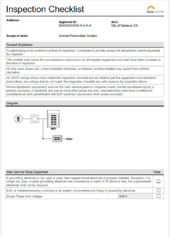What's the difference between a DIYer and a "professional installer" from the apps point of view?
To your question, I don't know the answer, but the utility distinguishes self-installers from those with a contractor's license. I imagine the app could be set to work similarly, trusting experienced installers with more rope than self-installers.
Safe and affordable home solar through permitting automation.
solarapp.nrel.gov
A year on, more locations use it:
Safe and affordable home solar through permitting automation.
solarapp.nrel.gov
The utility wouldn't be the one making the distinction here. SolarAPP+ has to be adopted by the city (or county) permit office. Then, after system has been entered and checked for correctness by SolarAPP+ everything is electronically submitted to the permit office, which charges and issues the permit. SolarAPP+ charged $25, which includes initial plus 2 revisions. Additional $25 after that. The training says permit office may charge for permit revisions.
SolarAPP+ requires verification of your contractor's license, so that is "professional installer".
I saw that Redwood City, where I have planned a system for my sister's house, had already adopted. Oakland (my "new" house) was running a pilot program for only their 6 largest installers. Couple of weeks ago Oakland just opened it to all so I am proceeding.
It is menu driven, enter type of tie-in, breaker panel busbar and main breaker rating, compliance method such as 120% rule etc., inverter and PV panel models, mounting structure, location of standoffs, etc. Upload all data sheets.
It allows exactly one model PV panel and two models of string inverter.
Conductor derating allows up to 9 (!?) current carrying conductors for PV DC, 3 for AC output of inverter on one conduit. It declares that Neutral counts as a current carrying conductor (!). I was going to put a breaker panel in my garage for loads, 2x GT PV inverters, later 2x battery inverters. Conduit run to back of house where I was going to put the inverters inside crawl space. I was going to use one conduit run, looks like I will have to run separate conduit to each inverter because they didn't implement wire count and derating for that section.
It allows relocation of circuits to new panel that gets the inverters only if conduit under 2' (therefore not derating.)
I considered Romex for that run, but "NM" is only allowed for something like in attic between microinverters. SolarAPP+ wouldn't allow NM for string inverters. Maybe trying to fit "greatest common denominator", something acceptable to all jurisdictions.
Oh, supports PV + battery (looks like a bunch more code requirements for battery). But only first system installed, no additions including no battery addition to existing PV system.
My NEM 2.0 reservation is PV only. PG&E will allow battery to be added, but only after the fact. I tried to apply for battery system on-line, but it said because existing PV system in progress, have to pick up the d*mn phone and call. I want to get their approval with Sunny Boy Storage + LG RESU-10H while its CEC listing is current.
Any body use it yet to can tell us more?



